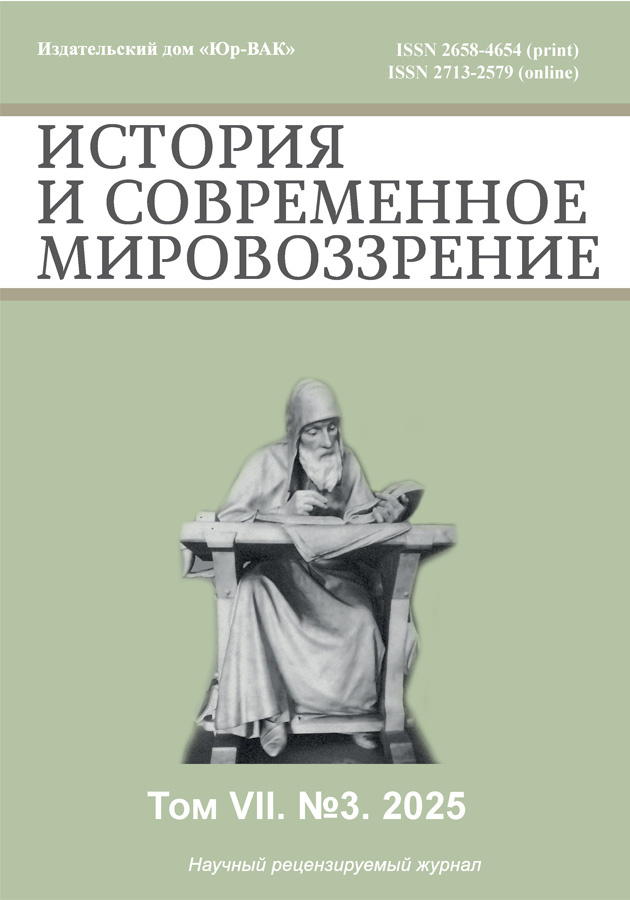Foreign relations of the Republic of Armenia and its international position in 1918–1920
- Autores: Stepanyan K.R.1
-
Afiliações:
- Armenian State Pedagogical University after Khachatur Abovyan
- Edição: Volume 7, Nº 3 (2025)
- Páginas: 134-144
- Seção: DEBATING ISSUES OF GENERAL HISTORY AND INTERNATIONAL RELATIONS
- URL: https://journals.eco-vector.com/2658-4654/article/view/695641
- DOI: https://doi.org/10.33693/2658-4654-2025-7-3-134-144
- EDN: https://elibrary.ru/nhujcy
- ID: 695641
Citar
Texto integral
Resumo
The article analyzes the foreign policy situation of the Republic of Armenia (1918–1920), especially in the context of the Treaty of Sèvres. It presents Armenia's diplomatic relations with various states, regional contradictions with neighboring countries — Georgia, Azerbaijan, and Turkey — as well as the policy of the Great Powers regarding the Armenian Question. Special attention is given to the content of the Treaty of Sèvres, its legal and moral significance as an international document which granted the Armenian people the right to establish a United Armenia, including Western Armenia. At the same time, the political reasons for the treaty’s non-implementation are examined, in particular the strengthening of the Kemalist movement and the inconsistency of the Great Powers. The article emphasizes the importance of the Treaty of Sèvres in the process of affirming the historical rights of the Armenian people, even though it remained unfulfilled.
Palavras-chave
Texto integral
Sobre autores
Khachatur Stepanyan
Armenian State Pedagogical University after Khachatur Abovyan
Autor responsável pela correspondência
Email: kh.stepanyan@gmail.com
Dr. Sci. (Hist.), Professor, Head of the Chair of World History and its Teaching Methods
Armênia, YerevanBibliografia
- Vratsyan S. Republic of Armenia. Yerevan. Hayastan. 1993. 542. (in Armenian).
- Galoyan G. Armenia and the Great Powers in 1917–1923. Yerevan.Gitutyun. 1999. 540. (in Armenian).
- Jamalyan A. Armenian-Georgian Entanglement. (Preface and notes by Kh. Stepanyan) Yerevan. Armenian State Pedagogical University after Kh. Abovyan, Mitk Analytical Center 2011. 244. (in Armenian).
- Makhmuryan G. British Policy in Armenia and Transcaucasia in 1918–1920. Yerevan. Lusakn. 2002. 309.
- Melkonyan A. Javakhk in the 19th century and in the first quarter of the 20th century. Yerevan. Zangak-97. 2003. 544 (in Armenian).
- Mukhanov V. Socialism of Winegrowers”, or the History of the First Georgian Republic. 1917–1921. Moscow. Kuchkovo Pole. 2019. 928.
- Hovhannisyan R. Republic of Armenia. Vol. I. Yerevan. Tigran Mets. 2005. 604; Vol. II. Yerevan. Tigran Mets. 2014. 708; Vol. III. Yerevan.Tigran Mets. 2014. 628; Vol. IV. Yerevan. Tigran Mets. 2016. 572. (in Armenian).
- Petrosyan G. Relations of the Republic of Armenia with non-state (non-Bolshevik) entities of Russia (1918–1920). Yerevan. YSU, 2006.416. (in Armenian).
- Safrastyan R. Mustafa Kemal: The Struggle against the Republic of Armenia, Yerevan. Tir, 2019. P. 140. (in Armenian).
- Stepanyan H. The Treaty of Sevres in the assessments of the socio-political thought of the Armenian Diaspora. “The Treaty of Sevres and the Arbitration Award of US President W. Wilson. A Critical Look from a 100-Year Distance”. (Collective monograph). Yerevan: Lusakn. 2020. Pp. 185–208. (in Armenian).
- Tumanyan M. Diplomatic History of the Republic of Armenia, 1918–1920, Yerevan, National Archives of Armenia, 2012, 473.
- Khachatryan A. Eastern Armenian and Turkish Diplomatic Relations, Yerevan, National Archives of Armenia, 2010, 287 (in Armenian).
- Khurshudyan L. Partition of Armenia in 1920, Yerevan, Yerevan University Press, 2002, 316 p. (in Armenian).
Arquivos suplementares










